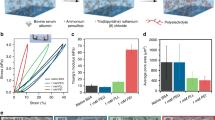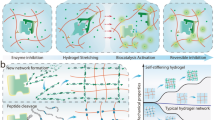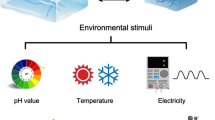Abstract
Certain proteins undergo a substantial conformational change in response to a given stimulus. This conformational change can manifest in different manners and result in an actuation, that is, catalytic or signalling event, movement, interaction with other proteins, and so on1,2,3,4,5,6. In all cases, the sensing–actuation process of proteins is initiated by a recognition event that translates into a mechanical action. Thus, proteins are ideal components for designing new nanomaterials that are intelligent and can perform desired mechanical actions in response to target stimuli. A number of approaches have been undertaken to mimic nature's sensing–actuating process1,2,3,4,5. We now report a new hybrid material that integrates genetically engineered proteins within hydrogels capable of producing a stimulus-responsive action mechanism. The mechanical effect is a result of an induced conformational change and binding affinities of the protein in response to a stimulus. The stimuli-responsive hydrogel exhibits three specific swelling stages in response to various ligands offering additional fine-tuned control over a conventional two-stage swelling hydrogel. The newly prepared material was used in the sensing, and subsequent gating and transport of biomolecules across a polymer network, demonstrating its potential application in microfluidics and miniaturized drug-delivery systems.
This is a preview of subscription content, access via your institution
Access options
Subscribe to this journal
Receive 12 print issues and online access
$259.00 per year
only $21.58 per issue
Buy this article
- Purchase on Springer Link
- Instant access to full article PDF
Prices may be subject to local taxes which are calculated during checkout




Similar content being viewed by others
References
Soong, R. K. et al. Powering an inorganic nanodevice with a biomolecular motor. Science 290, 1555–1558 (2000).
Liu, H. et al. Control of a biomolecular motor-powered nanodevice with an engineered chemical switch. Nature Mater. 1, 173–177 (2002).
Kroger, N., Deutzmann, R. & Sumper, M. Polycationic peptides from diatom biosilica that direct silica nanosphere formation. Science 286, 1129–1132 (1999).
Brott, L. L. et al. Ultrafast holographic nanopatterning of biocatalytically formed silica. Nature 413, 291–293 (2001).
Meyer, D. E. & Chilkoti, A. Purification of recombinant proteins by fusion with thermally responsive polypeptides. Nature Biotechnol. 17, 1112–1115 (1999).
Knoblauch, M. et al. ATP-independent contractile proteins from plants. Nature Mater. 2, 600–603 (2003).
Beebe, D. J. et al. Functional hydrogel structures for autonomous flow control inside microfluidic channels. Nature 404, 588–590 (2000).
Byrne, M. E., Park, K. & Peppas, N. A. Molecular imprinting within hydrogels. Adv. Drug Del. Rev. 54, 149–161 (2002).
Galaev, I. Y. & Mattiasson, B. 'Smart' polymers and what they could do in biotechnology and medicine. TIBTECH 17, 335–340 (1999).
Obaidat, A. A. & Park, K. Characterization of protein release through glucose-sensitive hydrogel membranes. Biomaterials 18, 801–806 (1997).
Torres-Lugo, M. & Peppas, N. A. Preparation and characterization of P(MAA-g-EG) nanospheres for protein delivery applications. J. Nanoparticle Res. 4, 73–81 (2002).
Hoffman, A. S. Hydrogels for biomedical applications. Adv. Drug Del. Rev. 43, 3–12 (2002).
Guiseppi-Elie, A., Brahim, S. I. & Narinesingh, D. A chemically synthesized artificial pancreas: release of insulin from glucose-responsive hydrogels. Adv. Mater. 14, 743–746 (2002).
Van der Linden, H. J., Herber, S., Olthuis, W. & Bergveld, P. Stimuli-sensitive hydrogels and their applications in chemical (micro)analysis. Analyst 128, 325–331 (2003).
Zhao, B. & Moore, J. S. Fast pH- and ionic strength-responsive hydrogels in microchannels. Langmuir 17, 4748–4763 (2001).
Holz, J. H., Holz, J. S., Munro, C. H. & Asher, S. A. Intelligent polymerized crystalline colloidal arrays: novel chemical sensor materials. Anal. Chem. 70, 780–781 (1998).
Tanaka, T. et al. Phase transitions in ionic gels. Phys. Rev. Lett. 45, 1636–1639 (1980).
Zhang, X.-Z., Zhuo, R.-X., Cui, J.-Z. & Zhang, J.-T. A novel thermo-responsive drug delivery system with positive controlled release. Int. J. Pharmaceutics 235, 43–50 (2002).
Wang, C., Stewart, R. J. & Kopecek, J. Hybrid hydrogels assembled from synthetic polymers and coiled-coil protein domains. Nature 397, 417–420 (1999).
Jager, E. W. H., Smela, E. & Inganas, O. Microfabricating conjugated polymer actuators. Science 290, 1540–1545 (2000).
Low, L.-M., Seetharaman, S., He, K.-Q. & Madou, M. J. Microactuators toward microvalves for responsive controlled drug delivery. Sens. Actuat. B 67, 149–160 (2000).
Rosiak, J. M. & Yoshii, F. Hydrogels and their medical applications. Nucl. Instr. Meth. Physics Res. B 151, 56–64 (1999).
Miyata, T., Uragami, T. & Nakamae, K. Biomolecule-sensitive hydrogels. Adv. Drug Del. Rev. 54, 79–98 (2002).
Petka, W. A, Harden, J. L., McGrath, K. P., Wirtz, D. & Tirrell, D. A. Reversible hydrogels from self-assembling artificial proteins. Science 281, 389–392 (1998).
Miyata, T., Asami, N. & Uragami, T. A reversibly antigen-responsive hydrogel. Nature 399, 766–769 (1999).
Deo, S. K. et al. Responsive drug delivery systems. Anal. Chem. 76, 207A–213A (2003).
Kopecek, J. Swell gels. Nature 417, 388–389 (2002).
Schauer-Vukasinovic, V. & Daunert, S. Purification of recombinant proteins based on the interaction between a phenothiazine-derivatized column and a calmodulin fusion tail. Biotechnol. Prog. 15, 513–516 (1999).
Schauer-Vukasinovic, V., Cullen, L. & Daunert, S. Rational design of a calcium sensing system based on induced conformational changes of calmodulin. J. Am. Chem. Soc. 119, 11102–11103 (1997).
Douglass, P. M., Salins, L. E., Dikici, E. & Daunert, S. Class-selective drug detection: fluorescently-labeled calmodulin as the biorecognition element for phenothiazines and tricyclic antidepressants. Bioconjugate Chem. 13, 1186–1192 (2002).
Lu, C.-H., Wang, J. & Deng, K.-L. Imaging and profiling surface microstructures with noninterferometric confocal laser feedback. Appl. Phys. Lett. 66, 2022–2024 (1995).
Kim, S. & Chu C. Pore structure analysis of swollen dextran-methacrylate hydrogels by SEM and mercury intrusion porosimetry. J. Biomed. Mater. Res. 53, 258–266 (2000).
Acknowledgements
The authors wish to thank Aaron A. Urbas for assistance generating hydrogel microdome surface maps. This work was supported by the National Institutes of Health (EB003072) and the Kentucky Science & Technology Corporation. J.D.E. acknowledges support from the National Science Foundation-Integrated Graduate Education Research Training program (NSF-IGERT) for a Predoctoral fellowship.
Author information
Authors and Affiliations
Corresponding author
Ethics declarations
Competing interests
The authors declare no competing financial interests.
Supplementary information
Supplementary Information
Supplementary information (PDF 174 kb)
Supplementary Information
Supplementary figures S1, S2, S3 and S4; supplementary table S1 (PDF 895 kb)
Rights and permissions
About this article
Cite this article
Ehrick, J., Deo, S., Browning, T. et al. Genetically engineered protein in hydrogels tailors stimuli-responsive characteristics. Nature Mater 4, 298–302 (2005). https://doi.org/10.1038/nmat1352
Received:
Accepted:
Published:
Issue Date:
DOI: https://doi.org/10.1038/nmat1352
This article is cited by
-
Engineering shape memory and morphing protein hydrogels based on protein unfolding and folding
Nature Communications (2022)
-
Sensitizer-enhanced two-photon patterning of biomolecules in photoinstructive hydrogels
Communications Materials (2022)
-
Multi-compartment encapsulation of communicating droplets and droplet networks in hydrogel as a model for artificial cells
Scientific Reports (2017)
-
Pine cone scale-inspired motile origami
NPG Asia Materials (2017)
-
Hydraulic hydrogel actuators and robots optically and sonically camouflaged in water
Nature Communications (2017)



